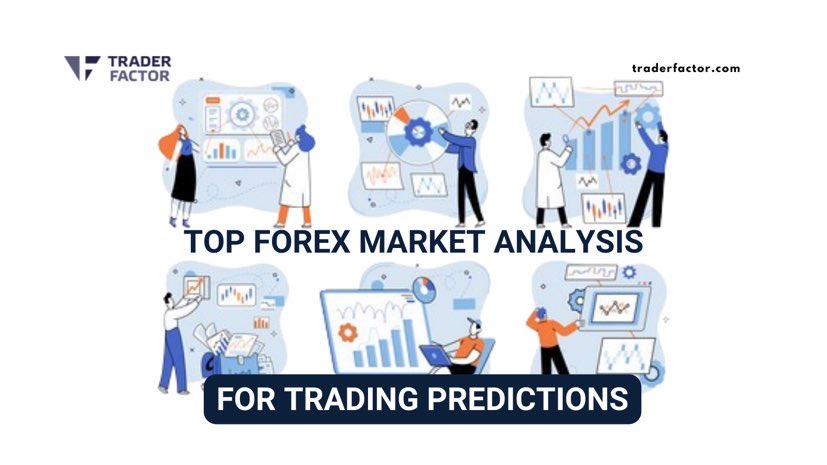Looking to make profitable trades in the forex market? Wondering which analysis method will give you the best trading predictions? Look no further!
In this article, we’ll break down the top forex market analysis techniques for you. From fundamental and technical analysis to sentiment and intermarket analysis, we’ll cover it all.
Get ready to uncover the most effective strategies that will help you make informed decisions and maximize your trading success. Let’s dive in!
Table of Contents
ToggleKey Takeaways
- Fundamental analysis focuses on economic, social, and political factors to provide insights into the overall health and stability of a country’s economy.
- Technical analysis studies historical price and volume data to identify patterns and trends, using tools such as moving averages, RSI, and Fibonacci retracement.
- Sentiment analysis analyzes the overall sentiment of market participants, using sentiment indicators and news sentiment analysis to make informed trading predictions based on the emotions and opinions of other traders.
- Intermarket analysis examines relationships between different financial markets, looking at correlations between currencies, stocks, commodities, and bonds to anticipate potential shifts in the forex market and identify opportunities for diversification and risk management.

Fundamental Analysis
If you want to make accurate trading predictions in the forex market, you need to understand the importance of fundamental analysis. This type of analysis focuses on the economic, social, and political factors that can influence currency exchange rates. By analyzing these factors, you can gain insights into the overall health and stability of a country’s economy, which can help you make informed trading decisions.
Fundamental analysis involves studying a variety of indicators, such as GDP growth rates, inflation rates, interest rates, employment data, and political stability. These indicators provide valuable information about the strength of a country’s economy and its currency. For example, if a country has a strong economy and a stable political environment, its currency is likely to be in high demand, leading to an increase in its value relative to other currencies.
In addition to economic indicators, fundamental analysis also considers social and political factors. For instance, changes in government policies, geopolitical tensions, and social unrest can all impact currency exchange rates. By staying informed about these factors, you can anticipate potential market movements and adjust your trading strategy accordingly.

Technical Analysis
To further enhance your trading predictions in the forex market, let’s delve into the realm of technical analysis. This form of analysis focuses on studying historical price and volume data to identify patterns and trends. By understanding these patterns, traders can make informed decisions about when to enter or exit trades. Technical analysis is based on the belief that historical price movements can provide insights into future price movements.
One popular tool used in technical analysis is moving averages. Moving averages help smooth out price fluctuations and identify the overall trend. Traders often use a combination of short-term and long-term moving averages to confirm trends and generate trading signals.
Another commonly used tool is the Relative Strength Index (RSI). The RSI measures the speed and change of price movements and helps traders determine if a currency pair is overbought or oversold. This information can be used to anticipate potential reversals in price.
In addition to moving averages and RSI, there are many other technical indicators and chart patterns that traders use to make predictions in the forex market. By combining these tools and conducting a thorough analysis, you can improve your trading predictions and increase your chances of success.
| Technical Indicator | Description | Purpose |
|---|---|---|
| Moving Averages | Smooth out price fluctuations | Identify trends |
| Relative Strength Index (RSI) | Measures speed and change of price movements | Determine overbought/oversold levels |
| Fibonacci Retracement | Identifies potential support and resistance levels | Predict reversals |
With a solid understanding of technical analysis and the use of these tools, you can gain valuable insights into market trends and make more accurate predictions in the forex market.

Sentiment Analysis
When it comes to forex trading, sentiment analysis can have a significant impact on your decisions. By analyzing the overall sentiment of market participants, you can gain insights into the market’s mood and potential future movements.
The accuracy of sentiment analysis is crucial, as it can help you make informed trading predictions based on the emotions and opinions of other traders.
Impact of Sentiment Analysis
To gauge the impact of sentiment analysis on trading predictions, you can analyze market trends and sentiments using various tools and indicators.
Sentiment analysis involves examining the emotions and opinions of market participants to understand their collective sentiment toward a particular asset or market. By analyzing this sentiment, traders can gain insights into the potential direction of the market.
One commonly used tool for sentiment analysis is the sentiment indicator, which measures the ratio of bullish to bearish positions in the market.
Another tool is the news sentiment analysis, which analyzes news articles and social media posts to determine the overall sentiment towards a specific currency or market.
Accuracy of Sentiment Analysis
- Reliable Data: Accurate sentiment analysis provides you with reliable data about market sentiment, helping you make informed trading decisions.
- Risk Assessment: By analyzing sentiment accurately, you can assess the level of risk associated with certain trades, allowing you to manage your portfolio effectively.
- Timing: Sentiment analysis accuracy enables you to identify shifts in market sentiment promptly. This gives you an advantage in entering or exiting trades at the right time.
Sentiment analysis accuracy plays a crucial role in informing your trading predictions. To understand its importance, consider the following:
With accurate sentiment analysis, you can gain valuable insights into market sentiment, allowing you to make better trading predictions and increase your chances of success. Make sure to utilize reliable sentiment analysis tools and techniques to enhance your trading strategy.

Intermarket Analysis
To accurately predict trading outcomes in the forex market, mastering Intermarket analysis is essential. Intermarket analysis involves examining the relationships between different financial markets to gain insights into potential movements in the forex market. By looking at the correlations between currencies, stocks, commodities, and bonds, you can identify trends and patterns that can help you make informed trading decisions.
One key aspect of intermarket analysis is understanding how changes in one market can impact another. For example, if there’s a rise in oil prices, this could lead to an increase in inflation, which may affect the value of a country’s currency. By keeping an eye on these intermarket relationships, you can anticipate potential shifts in the forex market and adjust your trading strategies accordingly.
Additionally, intermarket analysis can help you identify potential opportunities for diversification. By analyzing the correlations between different markets, you can identify assets that tend to move in opposite directions. This can help you spread your risk and potentially increase your profits.

Quantitative Analysis
You can enhance your forex trading predictions by incorporating quantitative analysis techniques. By utilizing quantitative analysis, you can make data-driven decisions and increase the accuracy of your trading predictions. Here are three key benefits of incorporating quantitative analysis into your forex trading strategy:
- Improved accuracy: Quantitative analysis allows you to analyze historical data and identify patterns and trends that may influence currency prices. By using statistical models and algorithms, you can make more accurate predictions about future market movements.
- Reduced emotional bias: Emotions can often cloud judgment and lead to poor trading decisions. Quantitative analysis helps eliminate emotional bias by relying on objective data and predefined rules. This allows you to make rational decisions based on facts rather than emotions.
- Backtesting and optimization: Quantitative analysis enables you to backtest your trading strategies using historical data. By simulating trades and analyzing past performance, you can identify which strategies work best and fine-tune your approach for optimal results.
Incorporating quantitative analysis into your forex trading strategy can significantly improve your trading predictions. By leveraging data, minimizing emotional bias, and optimizing your strategies, you can make more informed decisions and increase your chances of success in the forex market.

Seasonal Analysis
Incorporate seasonal analysis into your forex trading strategy to further enhance your trading predictions. Seasonal analysis involves studying patterns and trends that occur at specific times of the year in the forex market. By analyzing historical data, you can identify recurring patterns and use them to make more accurate predictions about future market movements.
One of the main benefits of seasonal analysis is that it helps you anticipate potential market trends based on historical data. For example, if you notice that a particular currency tends to strengthen during a certain season, you can adjust your trading strategy accordingly. By aligning your trades with these seasonal trends, you increase the likelihood of making profitable trades.
To incorporate seasonal analysis into your trading strategy, start by collecting historical data for the currency pairs you’re interested in. Look for patterns and trends that repeat themselves during specific times of the year. Pay attention to economic events, holidays, and other factors that may influence market behavior during these periods.
It is important to note that while seasonal analysis can provide valuable insights, it shouldn’t be the sole basis for your trading decisions. It should be used in conjunction with other forms of analysis, such as technical and fundamental analysis, to make well-informed trading predictions. By combining different types of analysis, you can develop a more comprehensive and reliable trading strategy.

Frequently Asked Questions
How Can I Use Fundamental Analysis to Predict Market Movements in the Forex Market?
To predict market movements in the forex market, you can use fundamental analysis. It involves analyzing economic indicators, news events, and political factors to determine the future direction of currency pairs.
What Are the Key Indicators and Data Points That Technical Analysts Look at When Analyzing the Forex Market?
When analyzing the forex market, technical analysts look at key indicators and data points. These include price charts, moving averages, support and resistance levels, and various technical indicators like RSI and MACD.
How Does Sentiment Analysis Help Traders Make Predictions About the Forex Market?
Sentiment analysis helps you make forex market predictions by analyzing public sentiment towards currencies. It can gauge positive or negative emotions, enabling you to anticipate market trends and make informed trading decisions.
What Is Intermarket Analysis and How Does It Impact Forex Trading Predictions?
Intermarket analysis is the study of how different markets influence each other. It impacts forex trading predictions by analyzing the relationships between currencies, commodities, and other financial markets to make more accurate forecasts.
Can Quantitative Analysis Be Used to Accurately Forecast Trends in the Forex Market?
Yes, quantitative analysis can accurately forecast trends in the forex market. By analyzing historical data and using mathematical models, you can identify patterns and make predictions that can guide your trading decisions.

Conclusion
In conclusion, when it comes to predicting forex market trends, a combination of fundamental analysis, technical analysis, sentiment analysis, intermarket analysis, quantitative analysis, and seasonal analysis is essential.
By utilizing these various tools, traders can gain a comprehensive understanding of the market and make informed decisions.
Remember, staying updated with market news and trends is crucial for successful trading.















